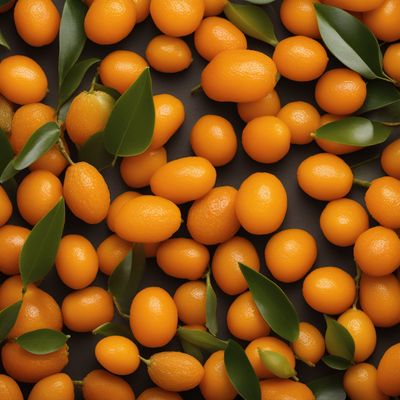
Ingredient
Kumquats
Tangy Citrus Delights: Exploring the World of Kumquats
Kumquats are small, bite-sized fruits that measure about 1-2 inches in length. They have a thin, edible peel that is bright orange in color and a juicy flesh that ranges from pale yellow to orange. The flavor of kumquats is a delightful balance of sweetness and tanginess, with the peel providing a slightly bitter note. The texture is firm and crunchy, similar to that of a grape, and the fruit contains small, edible seeds. Kumquats are prized for their refreshing taste and vibrant appearance, making them a versatile ingredient in various culinary creations.
Origins and history
Kumquats are native to China and have a long history dating back over 2,000 years. They were introduced to Europe in the 19th century and later made their way to North America. Kumquats have cultural significance in Chinese New Year celebrations, where they symbolize good luck and prosperity. Today, they are widely cultivated in countries such as China, Japan, the United States, and Brazil.
Nutritional information
Kumquats are a nutritious fruit, rich in vitamin C, fiber, and antioxidants. They are low in calories, with approximately 71 calories per 100 grams, making them a healthy addition to any diet.
Allergens
Kumquats are not commonly associated with allergies, but individuals with citrus allergies should exercise caution when consuming them.
How to select
When selecting kumquats, look for fruits that are firm and plump, with a vibrant orange color. Avoid any that are overly soft or have blemishes on the skin. The best-quality kumquats will have a glossy appearance and a fragrant aroma.
Storage recommendations
To maintain the freshness of kumquats, store them in a cool, dry place or in the refrigerator. They can be kept at room temperature for a few days, but for longer storage, place them in a perforated plastic bag in the refrigerator, where they can last for up to two weeks.
How to produce
Kumquats can be grown in containers or in the ground, making them suitable for amateur gardeners. They thrive in warm climates and require well-drained soil and plenty of sunlight. Regular watering and occasional fertilization will help the plants produce an abundant crop of kumquats.
Preparation tips
Kumquats can be enjoyed whole, including the peel, or the peel can be removed if desired. To eat them whole, simply rinse the fruit, remove any stems, and pop them into your mouth. The peel provides a burst of flavor, while the flesh offers a juicy and tangy experience. Kumquats can also be sliced and used as a garnish for salads, desserts, or cocktails. They can be candied, preserved, or made into marmalades for a sweet treat.
Culinary uses
Kumquats are a versatile ingredient in both sweet and savory dishes. They can be used to add a tangy twist to salads, salsas, and marinades. Kumquat marmalades and preserves are popular spreads, and they can be used in baking to add a burst of citrus flavor to cakes, tarts, and cookies. They also make a refreshing addition to cocktails and mocktails.
Availability
Kumquats are commonly available in countries such as China, Japan, the United States (particularly Florida and California), and Brazil.

